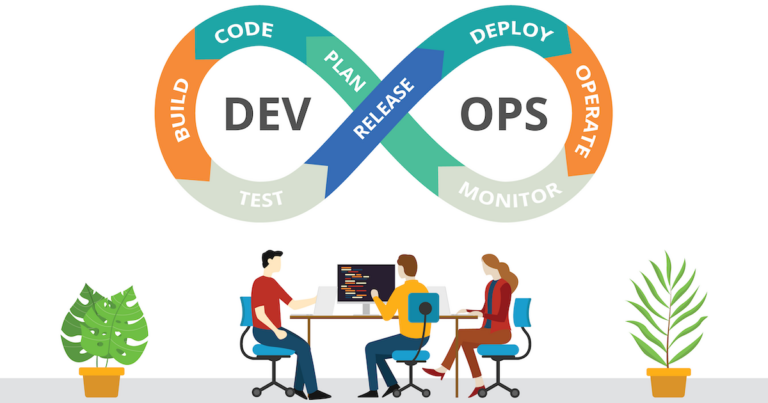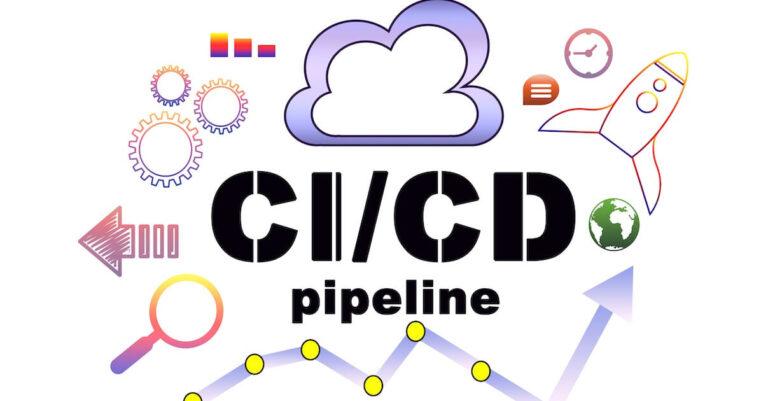DevOps is an amalgamation of cultural change and technological advancement. The right mindset is vital for the success of DevOps service as well as the use of innovative tools. DevOps lays the foundation of cloud-native application development and ensures faster delivery with higher reliability, which is impossible with automation depending on the right choices of tools. Here is a list of incredible DevOps tools that help teams succeed in project development, quick delivery, lifecycle management, and more.
1. Git
Git is a free and open-source distributed version control system. It is popular for its capacity to handle small to large applications. As a DevOps tool, Git empowers developers to work collaboratively and ensures faster release cycles. The most exciting feature of Git is that it enables repos, pull requests, etc., and supports seamless integration, such as you can connect any additional support systems to GitHub and work freely. Other advantages include local branching, convenient staging areas, and multiple workflows, which makes it a top SCM tool for DevOps.
2. Stash
Stash which was later renamed Bitbucket Server, is a repository management system of Atlassian. It is a popular choice among enterprise customers due to added advantages it offers, such as security, administration, integration, and ease of use. Stash complements Git and vice-versa as you can think of Git as a kernel and stash as the shell surrounding the kernel.
3. GitHub
GitHub is a code hosting platform that supports version control and collaboration. It allows the cross-functional team to work together on projects from anywhere. The incredible features that make GitHub a popular choice of millions of developers include collaborative coding, additional features for enterprise customers, project management, automation with the help of CI/CD, and added security.
4. Docker
To build container-based applications, Docker is the first and foremost choice of project managers. It is a lightweight tool that allows developers to create a docker container image that works as a standalone, executable package with all the things an application needs to run. It has become an indispensable tool to DevOps success due to providing benefits such as a standardized packaging format for diverse applications and support of container runtime that runs on various Linux and Windows Server Oss. There is also a Docker Hub that allows you to explore millions of images from the community and verified publishers.
5. Chef
An open-source tool used for automation and configuration management, Chef is a widely popular DevOps tool. It provides “Cookbooks” that allow developers to code the infrastructure in languages specific to domains. Developers can define configurations as code with Chef. It easily integrates with all leading cloud platforms such as Microsoft Azure, Amazon AWS, GCP, etc.
6. Puppet
Puppet is an open-source configuration management tool. It uses declarative programming for system configuration, deployments, and server management DevOps tools. It is compatible with most platforms and offers a speedy setup of pre-configured servers. It has adopted master-slave architecture that provides real-time reporting, node management, and several other tasks through an intuitive user interface.
7. Ansible
Ansible is one of the most effective IT orchestration and configuration management tools. It offers a softer outlook by not hogging on your device’s resources in the background. Ansible is widely utilized to push new changes with the existing system and configure newly deployed machines. In addition, the other thing that makes this tool an absolute favorite amongst IT companies is that it helps lower the costs of infrastructure and increases the speed of scalability.
8. Terraform
Terraform is an open-source tool from HashiCorp that allows DevOps engineers to programmatically provision the physical resources an application requires to run. It is one of the popular tools used within enterprises for Infrastructure as code. Terraform allows developers to logically manage, monitor, and provision resources without needing an operations team to manually configure each required resource. It uses a JSON-like configuration language called HCL (HashiCorp Configuration Language). HCL’s simple syntax makes it easy for DevOps teams to provision and re-provision infrastructure across multiple clouds and on-premises data centers.
9. Maven
A maven is an open-source tool developed by Apache Group to build, publish, and deploy several projects at once for better management. It allows developers to build and document the lifecycle framework. Maven is written in Java and is a favorite among java developers as it makes their life easier. The tool can also be used to build projects written in C#, Ruby, Scala, etc. Maven has adopted a project object model and focuses on the simplification and standardization of the building processes like builds, documentation, dependencies, reports, SCMs, distribution, releases, and others.
10. JUnit
JUnit is a unit testing framework and is easy to integrate with other popular DevOps tools such as Maven. Some of the popular features of the tools include fixtures, test suits, JUnit classes, and test runners. Used by Java developers, it has been important in the development of test-driven development.
11. Selenium
Selenium is a widely adopted framework for web applications. Its IDE comes with a full-fledged integrated development environment, authoring checks with the help of domain-specific language (Selenese) to write scripts in several popular programming languages such as PHP, Python, Ruby, Perl, C#, and Java. It is also used to record or playback tools for developing tests.
12. TestNG
TestNG is another popular testing framework used by DevOps engineers. It covers all categories of tests: unit, functional, end-to-end, integration, etc. The power-packed features such as flexible configuration, annotations, support for data-driven testing and parameters, logging, default JDK functions for runtime, as well as support for a variety of tools and plug-ins (IDEA, Eclipse, Maven, etc.) make TestNG a must-have tool for DevOps success.
13. Blazemeter
Blazemeter has already established itself as a market leader in performance testing. Furthermore, it has expanded the capabilities of its platform and has added additional functionalities to allow complete continuous testing. Developers, testers, and DevOps engineers all get control over all aspects of testing in one place, offering superior collaboration. It comes with many functionalities that simplify the day-to-day life of QAs and DevOps engineers, like creating and managing test assets, building mock services, running GUI functional tests, performance tests, API testing as well as API monitoring.
14. Vagrant
Vagrant is designed keeping in view the requirements of all players of software development, such as designers, developers, and operations. It provides the fastest and easiest way to create a virtual machine environment for a single workflow. Vagrant saves development environment setup time and helps increase production parity through its focus on automation.
15. Docker Swarm
Docker Swarm is Docker’s native orchestration tool for Docker containers. It enables you to set up and manage a cluster of Docker nodes as a single virtual system. It means you have to run Docker on multiple hosts on your computers. To get control over the swarm cluster, a manager is used that primarily handles and controls containers. A swarm manager function allows you to establish a primary manager instance and multiple replica instances to avoid scenarios when the primary fails. Hence, you will have more than one manager in a swarm. The manager node and worker node are the two primary components of the swarm.
16. Kubernetes
Kubernetes is a highly popular and widely adopted orchestration tool available in the market. It is an open-source tool that enables automated deployment, scaling, and management of containerized applications. Kubernetes combined best-of-breed ideas and practices of the community. It sits in the center of microservices and cloud-native software deployment and management.
17. Istio
Microservices have simplified application refactoring and migration to the cloud but managing the number of microservices is not as easy as it seems. Microservices-based application architecture brings new development and architecture concerns, especially how developers apply networking policies for security, encryption, observability, and telemetry elements. Istio, as a service mesh, is the answer to all these worries. It places a sidecar proxy next to each container and abstracts these networking capabilities to a control plane. It is developed on Envoy.
18. Jenkins
A big part of DevOps practices is about automating and deploying new interactions more efficiently. And it includes developing and setting up a streamlined continuous integration and continuous delivery (CI/CD) pipeline. That’s where Jenkins comes in. It is an open-source automation server and is enabled with hundreds of plug-ins enabling DevOps engineers to automate the building, deployment, and testing of software projects. Being a decade old, Jenkins is still used and is considered highly effective. However, there are several other Jenkins alternative tools available that are becoming popular these days to meet evolving requirements that you can check for your project use-case needs.
19. Brigade.js
Brigade is a framework for scripting multiple tasks simultaneously and executing them inside containers. It is an open-source Kubernetes-native tool designed to help devs and ops get their work done quickly. This allows creating any ordered workflow of containers in Kubernetes and triggering the workflow by listening to arbitrary events. Brigade exists as a service inside Kubernetes and is based on JavaScript.
20. Openshift
OpenShift is a Kubernetes container platform. It is a product of RedHat and helps software engineers and IT operations teams modernize existing enterprise applications. The tool accelerates development and delivery processes and allows its user to deliver new applications faster. It offers a common platform to both the development and operations team along with a set of tools to establish a foundation for building, deploying, and managing containerized applications on any infrastructure, whether it’s on-premise, multi-cloud, or hybrid cloud.
21. Nagios
Nagios has become an IT standard in IT infrastructure monitoring. The tool is open source and has been designed with core components to keep running on the Linux working framework to monitor devices running Linux, Windows, and Unix OS. The projects require continuous monitoring of servers, applications, networks, and business processes & services in a DevOps culture that makes use of Nagios. It not just monitors the state of the applications or services but also alters the technical staff of the problem in case of failure. Hence, the tools allow technical staff to be proactive in their efforts by keeping tabs over Nagios performance reports regarding remediation required before or after outages that could affect business processes, end-users, or customers.
22. Prometheus
Prometheus is an open-source project and is considered one of the best monitoring systems available in the market. It is also a cloud-native computing foundation project and comes with highly advanced features such as a multidimensional data model, autonomous single server nodes, flexible query language, and multiple modes of graphing and dashboarding support. Prometheus collects metrics from configured targets at given intervals, check rule expressions, provides the results, and trigger alters if conditions are observed to be true. Since it is native to containerized environments and integrates well with Kubernetes, DevOps organizations are moving to Prometheus.
23. Grafana
Grafana is an open observability platform offering analytics & monitoring solutions for every database. It is widely adopted alongside Prometheus. DevOps teams run Grafana on top of Prometheus as Prometheus offers rich metrics and provides a powerful querying language; Grafana, on the other hand, transforms metrics into meaningful visualizations. Grafana is one of the best tools available that help in creating, exploring, and sharing beautiful dashboards with the team and foster a data-driven culture within organizations.
Conclusion
Programming isn’t just about shipping quality code; it’s about efficient execution. The availability of excellent open-source DevOps tooling means that more and more architects can adopt a DevOps approach within their deployment models. However, DevOps as a practice, as well as its underlying technology, is constantly evolving. We will keep our list updated with new tools that help define DevOps adoption at every stage of development and project success.




